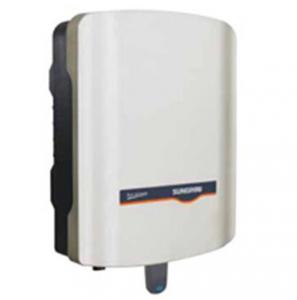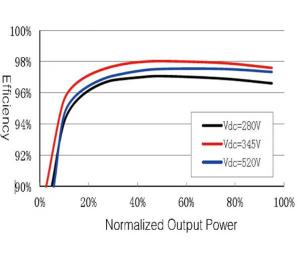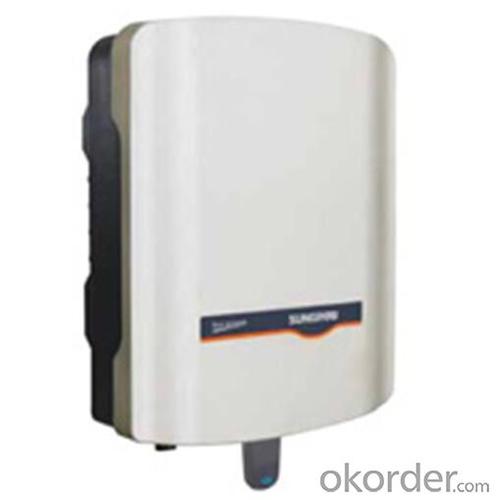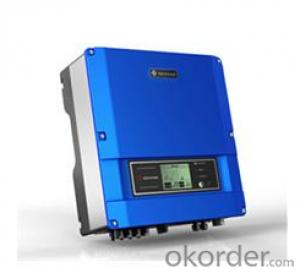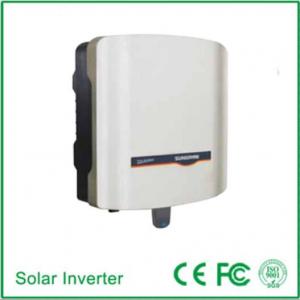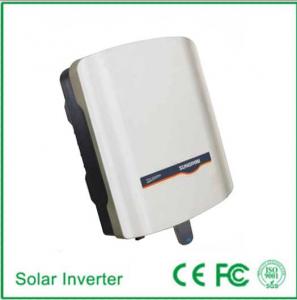300 Watt Solar Inverter SG5KTL-D Solar Photovoltaic Grid-Connected Inverter
- Loading Port:
- China Main Port
- Payment Terms:
- TT or LC
- Min Order Qty:
- 50000 unit
- Supply Capability:
- 3000000 unit/month
OKorder Service Pledge
OKorder Financial Service
You Might Also Like
1. Structure of Solar Photovoltaic Grid-Connected Inverter SG5KTL-D Description
A solar inverter, or PV inverter, or Solar converter, converts the variable direct current (DC) output of a photovoltaic (PV) solar panel into a
utility frequency alternating current (AC) that can be fed into a commercial electrical grid or used by a local, off-grid electrical network. It is a
critical BOS–component in a photovoltaic system, allowing the use of ordinary AC-powered equipment. Solar inverters have special
functions adapted for use with photovoltaic arrays, including maximum power point tracking and anti-islanding protection.
2. Main Features of the Solar Photovoltaic Grid-Connected Inverter SG5KTL-D
• Max. input voltage 600V, compatible with different PV panel and string design
• Dual MPPT, compatible with different residential rooftop system design
• Only 11kg, easy for handling and installation
• Max. Efficiency at 98.0%
• Ultra-quiet, suitable for residential use
• Access to home WiFi system, easy to enjoy the online monitoring
• Wireless communication design, intelligent mobile phone local and remote monitoring
• Product certification: TÜV, CE, AS4777, AS/NZS 3100, VDE AR N 4105
•Manufacturer certification: ISO 9001, ISO 14001, OHSAS 18000
3. Solar Photovoltaic Grid-Connected Inverter SG5KTL-D Images
4. Solar Photovoltaic Grid-Connected Inverter SG5KTL-D Specification
Input Side Data |
|
Max. PV input power | 5400W |
Max. PV input voltage | 600V |
Startup voltage | 150V |
Nominal input voltage | 345V |
MPP voltage range | 125~560V |
MPP voltage range for nominal power | 240~520V |
No. of MPPTs | 2 |
Max. number of PV strings per MPPT | 1 |
Max. PV input current | 22A(11A/11A) |
Max. current for input connector | 20A |
Output Side Data |
|
Nominal AC output power | 5000W / 4600W ( Australia )* |
Max AC output power(PF=1) | 5000W |
Max. AC output apparent power | 5000VA |
Max. AC output current | 21.7A / 20A ( Australia )* |
Nominal AC voltage | 230Vac (Single phase) |
AC voltage range | 180~276Vac (May vary as per corresponding country’s grid standard) |
Nominal grid frequency | 50Hz/60Hz |
Grid frequency range | 45~55Hz/55~65Hz (May vary as per corresponding country’s grid standard) |
THD | < 3 % (Nominal power) |
DC current injection | <0.5 %In |
Power factor | >0.99@default value at nominal power, (adj. 0.8 overexited~0.8 underexcited) |
Protection |
|
Anti-islanding protection | YES |
LVRT | NO |
DC reverse connection protection | YES |
AC short circuit protection | YES |
Leakage current protection | YES |
DC switch | Optional |
DC fuse | NO |
Overvoltage protection | Varistors |
System Data |
|
Max. efficiency | 98.00% |
Max. European efficiency | 97.50% |
Isolation method | Transformerless |
Ingress protection rating | IP65 |
Night power consumption | <1W |
Operating ambient temperature range | -25~60℃ (>45℃ derating) |
Allowable relative humidity range | 0~100% |
Cooling method | Natural cooling |
Max. operating altitude | 4000m (>2000m derating) |
Display | LED, LCD(optional) |
Communication | WiFi (optional) |
DC connection type | MC4 |
AC connection type | Plug and play connector |
Certification | IEC61000-6-2,IEC61000-6-3, |
Mechanical Data |
|
Dimensions(W×H×D) | 360*390*133 mm |
Mounting method | Wall bracket |
Weight | 11kg |
* When the SG5KTL-D type countries choose to Australia, rated output power is 4600W, when the SG5KTL-D type countries choose to Australia, the maximum output current is 20A.
* Specifications subject to change without notice.
5. FAQ of Solar Photovoltaic Grid-Connected Inverter SG5KTL-D
Q1. What is the difference between inverter and solar inverter?
A1. Inverter only has AC inpput, but solar inverter both connect to AC input and solar panel, it saves more power.
Q2. What is the difference between MPPT&PWM?
A2. MPPT has higher efficiency, it can track the max power point and won't waste energy.
- Q: How does MPPT technology work in solar inverters?
- MPPT technology, or Maximum Power Point Tracking, is utilized in solar inverters to optimize the energy output of photovoltaic systems. It works by continuously tracking the maximum power point of the solar panel array, which is the voltage and current combination that allows the panels to generate the maximum power. The MPPT algorithm adjusts the operating voltage and current of the solar panels to match the optimal point, ensuring that the maximum amount of power is extracted from the solar array and converted efficiently by the inverter. By constantly adapting to changing environmental conditions, MPPT technology maximizes the solar energy harvest, improving system efficiency and overall performance.
- Q: What is the role of a solar inverter in maximizing solar panel output?
- The role of a solar inverter in maximizing solar panel output is to convert the direct current (DC) electricity generated by the solar panels into alternating current (AC) electricity that can be used in our homes and businesses. Additionally, the inverter ensures that the solar panels operate at their maximum power point, optimizing their efficiency and output. It also monitors and controls the flow of electricity, ensuring safety and preventing any damage to the solar panels or the electrical system.
- Q: Can a solar inverter be used with a solar-powered backup generator?
- Certainly, a solar-powered backup generator can indeed be utilized in conjunction with a solar inverter. The solar inverter's primary function is to convert the DC electricity generated by solar panels into AC electricity, which is suitable for powering household appliances and various electrical devices. Conversely, a solar-powered backup generator harnesses solar energy to either charge its batteries or store any surplus electricity. When the solar panels are actively generating electricity, the solar inverter will convert the DC electricity into AC electricity. This AC electricity can then be directly employed within the household or redirected back to the grid, assuming the system is interconnected. Should there be an excess of electricity being produced and the batteries of the solar-powered backup generator are fully charged, the solar inverter has the capability to divert this surplus electricity to other loads or devices. During periods when solar energy is either insufficient or unavailable, the solar-powered backup generator can seamlessly activate and provide the requisite electricity to power the house or recharge the batteries. In such cases, the solar inverter remains responsible for the conversion of the DC electricity generated by the solar-powered backup generator into AC electricity. To summarize concisely, employing a solar inverter alongside a solar-powered backup generator guarantees a continuous supply of electricity, even during instances of limited solar energy availability.
- Q: What is the role of a transformer in a solar inverter?
- The role of a transformer in a solar inverter is to convert the direct current (DC) power generated by the solar panels into alternating current (AC) power that can be used by household appliances and fed into the electrical grid. The transformer steps up or steps down the voltage as necessary to ensure efficient power transmission and distribution. Additionally, it provides electrical isolation and protection from voltage fluctuations, ensuring the safe and reliable operation of the solar inverter.
- Q: Can a solar inverter be used in standalone systems?
- Yes, a solar inverter can be used in standalone systems. Standalone systems, also known as off-grid systems, are not connected to the electrical grid and rely on alternative sources of power such as solar panels. Solar inverters are crucial in standalone systems as they convert the direct current (DC) produced by the solar panels into alternating current (AC) that is used to power household or commercial appliances.
- Q: What is the role of a solar inverter in grid management and stability?
- Solar inverters have a crucial role to play in the management and stability of the electrical grid when it comes to integrating solar power. They are responsible for converting the direct current electricity produced by solar panels into alternating current electricity that can be used by homes and businesses or fed back into the grid. When it comes to managing the grid, solar inverters are vital for maintaining its stability and reliability. They perform important functions such as voltage regulation, frequency control, and compensating for reactive power. By monitoring the grid conditions and adjusting the solar power output accordingly, inverters help to balance the supply and demand of electricity in real-time, ensuring grid stability. In addition to grid management, solar inverters also contribute to grid stability by improving the quality of power. They actively filter out harmonics, voltage fluctuations, and other electrical disturbances that can be caused by the intermittent nature of solar power generation. This ensures that the electricity generated by solar panels is of high quality and does not introduce any disruptions or damage to the electrical grid. Furthermore, solar inverters enable the seamless integration of solar power into the grid by allowing excess energy to be fed back into the system. This is known as net metering or feed-in tariff programs, which provide compensation for solar energy producers for the surplus electricity they produce. With the help of inverters, the generated solar energy can be efficiently transferred to the grid, reducing the reliance on traditional fossil fuel-based power generation and promoting renewable energy integration. In summary, the role of a solar inverter in grid management and stability is to ensure the smooth integration and optimal utilization of solar power while maintaining the stability, reliability, and quality of the electrical grid. It acts as a bridge between solar energy producers and the grid, facilitating the efficient and sustainable integration of renewable energy sources into the existing power infrastructure.
- Q: What is the maximum number of parallel inverters that can be installed in a solar system?
- The maximum number of parallel inverters that can be installed in a solar system depends on the specific requirements of the system and the available infrastructure. There is no fixed limit, as it varies based on factors such as the size of the system, the capacity of the inverters, the electrical load, and the design limitations. It is best to consult with a solar system designer or engineer to determine the optimal number of parallel inverters for a particular solar installation.
- Q: Can a solar inverter be used with different types of batteries?
- Yes, a solar inverter can be used with different types of batteries as long as the voltage and current ratings of the batteries are compatible with the inverter's specifications. However, it is important to ensure that the inverter is programmed or configured correctly to work with the specific battery chemistry and charging requirements to optimize performance and prevent any potential damage.
- Q: What is the role of a solar inverter in a solar-powered remote monitoring system?
- The role of a solar inverter in a solar-powered remote monitoring system is to convert the direct current (DC) electricity generated by the solar panels into alternating current (AC) electricity that can be used to power the monitoring system. It also ensures that the electricity generated matches the requirements of the monitoring equipment, regulates the voltage, and assists in efficient power transmission and distribution.
- Q: How does a solar inverter handle voltage and frequency regulation?
- A solar inverter handles voltage and frequency regulation by converting the direct current (DC) generated by solar panels into alternating current (AC) that matches the voltage and frequency of the electrical grid. It does this by using advanced power electronics and control systems to monitor and adjust the output voltage and frequency to meet the required standards. This ensures that the electricity generated by the solar panels is compatible with the grid and can be seamlessly integrated into the existing power supply.
Send your message to us
300 Watt Solar Inverter SG5KTL-D Solar Photovoltaic Grid-Connected Inverter
- Loading Port:
- China Main Port
- Payment Terms:
- TT or LC
- Min Order Qty:
- 50000 unit
- Supply Capability:
- 3000000 unit/month
OKorder Service Pledge
OKorder Financial Service
Similar products
Hot products
Hot Searches
Related keywords
